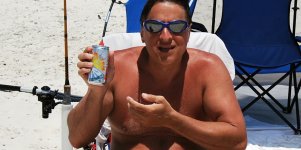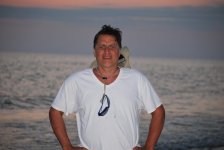That's the funniest thing I've read in a long while.
In your opinion
Since optimizing one set of parameters in a loudspeaker may degrade others, a designer has to do some picking and choosing. A speaker designed for the lowest possible IM distortion may not have the flattest response, and a speaker designed for the fastest decay characteristic may not have the widest dynamic range. In other words, I don't think it's possible to optimize all technical parameters at once.
This is why I mentioned different types of music in the previous post. In my experience, acoustical music benefits the most from a rapid and resonance-free decay characteristic. Music that has an electronic source (going through a guitar amp, for example) may benefit from optimizing other characteristics, such as dynamic range. Acoustical music isn't morally or esthetically superior to hip-hop, stadium rock, or London dance music; it just has different technical requirements for the playback system.
My loudspeakers are optimized for acoustical music and moderate-power Class A amplifiers. That's the niche they're designed for. Other designers with different priorities will design different loudspeakers, and they've made plenty of posts right here in the diyAudio forums.
This is why I mentioned different types of music in the previous post. In my experience, acoustical music benefits the most from a rapid and resonance-free decay characteristic. Music that has an electronic source (going through a guitar amp, for example) may benefit from optimizing other characteristics, such as dynamic range. Acoustical music isn't morally or esthetically superior to hip-hop, stadium rock, or London dance music; it just has different technical requirements for the playback system.
My loudspeakers are optimized for acoustical music and moderate-power Class A amplifiers. That's the niche they're designed for. Other designers with different priorities will design different loudspeakers, and they've made plenty of posts right here in the diyAudio forums.
Last edited:
Wellll. IMO you are belaboring the Blatantly Obvious.
Geee. Who woulda thought Live often bears NO resemblance to Canned reproduction
Erm.. Pretty well ever Kid with ears in the 70's .
Did you Miss all that?
But then this interminable thread reads wayyy too much like an Open Mouth Radio talk show .. IMO 10,000 opinions, all vying for position/prominence.
This forum is full of some of the most innovated stuff out there. Take information that suits you and move on. Easy.
I'll visit here 5 years from now if the same brilliant posters are still around.
You are definitely heading in the right direction however you should seriously consider a front loaded mid bass horn if at all possible.
+1
My loudspeakers are optimized for acoustical music and moderate-power Class A amplifiers. That's the niche they're designed for. Other designers with different priorities will design different loudspeakers, and they've made plenty of posts right here in the diyAudio forums.
I think it would be helpful if you can post some measurements of your speakers and an explanation of what your looking at/for.
Lynn,
I would think that with the ease of seeing a waterfall plot of the decay of a speaker that most designers would be using that as one of the major factors to look at while doing the initial development on the raw device. I know that is one of the major factors that I use along with the FR and making sure it covers the expected range I am after. Perhaps others don't do that but that seems rather silly today. When I see an impulse response and decay rate where there is a sharp peaked high Q situation I would focus in on that fact. I would avoid that if possible, I don't want to have to use notch filters to attempt to ameliorate a resonate problem that should be corrected in the device design if at all possible. I understand your thinking about this being a larger issue with acoustic music but really who wants that situation with any music just because it can be masked by other types of music.
I would think that with the ease of seeing a waterfall plot of the decay of a speaker that most designers would be using that as one of the major factors to look at while doing the initial development on the raw device. I know that is one of the major factors that I use along with the FR and making sure it covers the expected range I am after. Perhaps others don't do that but that seems rather silly today. When I see an impulse response and decay rate where there is a sharp peaked high Q situation I would focus in on that fact. I would avoid that if possible, I don't want to have to use notch filters to attempt to ameliorate a resonate problem that should be corrected in the device design if at all possible. I understand your thinking about this being a larger issue with acoustic music but really who wants that situation with any music just because it can be masked by other types of music.
Lynn,
I would think that with the ease of seeing a waterfall plot of the decay of a speaker that most designers would be using that as one of the major factors to look at while doing the initial development on the raw device. I know that is one of the major factors that I use along with the FR and making sure it covers the expected range I am after. Perhaps others don't do that but that seems rather silly today. When I see an impulse response and decay rate where there is a sharp peaked high Q situation I would focus in on that fact. I would avoid that if possible, I don't want to have to use notch filters to attempt to ameliorate a resonate problem that should be corrected in the device design if at all possible. I understand your thinking about this being a larger issue with acoustic music but really who wants that situation with any music just because it can be masked by other types of music.
I agree completely, Kindhornman. Unfortunately, the first prototype is in Dallas, more than 1000 miles away from Denver, Gary Dahl is in the Seattle area, more than 1500 miles away, and the other two builders are in Canada and Perth, Australia. My own personal speaker is probably six months or more from completion, depending on the results of the other collaborators.
As far as I can tell, both your speaker (and POOH's) are up and running, and probably no more than 50 feet away from where you make your posts. Is there any way either of you could post your 3D waterfall results, say over a 0~10 mSec window, with 30 dB or more of dynamic range?
No snark or irony intended, 3D waterfall results from high-efficiency speakers are really hard to come by, and seeing the waterfall data from your system, POOH's, or even Dr. Geddes' new NS15, would be quite interesting and much appreciated by the readers of diyAudio.
Perfectly serious here, no joking around, I'd really like to see your data posted on the forum. I've seen plenty from Gary Dahl, Gary Pimm, and Martin Seddon; I'd like to see what you've done for your own system, with the 3D waterfall the most informative of all.
Last edited:
Lynn,
It has been awhile since I have done any testing, now it has been more of design of the molded enclosure and amplification than basic driver design. But I will look through my files and see if I can find the waterfall plots. I actually did these with a friend and mentor of mine and he has the best B&K microphones and other test equipment that are somewhat beyond my Clio system that I presently have. When I can I would like to jump to the Kippel laser interferometry type testing but that will be awhile until that happens. I do have a very nice Earthworks preamp that is used strictly for testing purposes and one of there 1/4" microphones but the mic is surely not up to B&K standards. I have a B&K mic body but not the capsule yet. The decay properties were some of the basic parameters that we used when I first started developing my composite cones. It was interesting to see the changes I could make with the waterfall decay by changes in both the composite fiber types and combinations and also the resin properties that I could change at will. It was rather easy to extend the frequency range but at the cost of some horrid looking waterfall plots, the top end looked ragged and since I wasn't interested in producing a full range driver I never attempted to work out those problems.
It has been awhile since I have done any testing, now it has been more of design of the molded enclosure and amplification than basic driver design. But I will look through my files and see if I can find the waterfall plots. I actually did these with a friend and mentor of mine and he has the best B&K microphones and other test equipment that are somewhat beyond my Clio system that I presently have. When I can I would like to jump to the Kippel laser interferometry type testing but that will be awhile until that happens. I do have a very nice Earthworks preamp that is used strictly for testing purposes and one of there 1/4" microphones but the mic is surely not up to B&K standards. I have a B&K mic body but not the capsule yet. The decay properties were some of the basic parameters that we used when I first started developing my composite cones. It was interesting to see the changes I could make with the waterfall decay by changes in both the composite fiber types and combinations and also the resin properties that I could change at will. It was rather easy to extend the frequency range but at the cost of some horrid looking waterfall plots, the top end looked ragged and since I wasn't interested in producing a full range driver I never attempted to work out those problems.
I didn't say that, I have to find them and post them. It may take awhile to find the waterfall plots, lots of paperwork here.
ps. They were if I remember them done at the normal 1watt measurement that is fairly standard so not sure they would meet Lynn's criteria for dynamic range measurements.
ps. They were if I remember them done at the normal 1watt measurement that is fairly standard so not sure they would meet Lynn's criteria for dynamic range measurements.
Last edited:
ps. They were if I remember them done at the normal 1watt measurement that is fairly standard so not sure they would meet Lynn's criteria for dynamic range measurements.
I have no criteria for dynamic-range measurements, not a Klippel user, so have nothing to say about it. Impulse response and 3D waterfall are traditionally small-signal measurements, with the only tradeoff being cyclic ambient noise creeping into the measurement if power levels are too low.
Impulse response and 3D waterfall measurements are typically seen in low to moderate efficiency direct-radiator systems marketed to audiophiles, but are not too common with high-efficiency loudspeakers. I really welcome the use of these measurements in the high-efficiency domain.
I personally feel high-dollar speakers, and certainly the ones aimed at the audiophile market, should all come with impulse response (with start-stop markers visible), FR as calculated from the start-stop markers, and 3D waterfall responses (using the same start-stop markers). If I can publish all of these measurements in a speaker I donated to the Internet 20 years ago, I don't see any excuse at all for commercial vendors, who routinely make the same measurements for in-house use.
Another measurement rarely seen is the impulse response at different emission angles: 0 degrees, 5 degrees, 10 degrees, 15 degrees, and so on. Loudspeakers with diffraction problems, horn modes, or poor time alignment, have narrow spikes that appear at characteristic angles, and this is obvious in the impulse response vs angle measurements.
Last edited:
Hey, enjoy your tour in the Gulf, POOH! In the meantime, we're getting a severe weather/hailstorm/tornado warning around here ... that's Colorado in the springtime.
By the way, the new avatar are a pair of Western Kingbirds that grew up in a nest under the eaves of the house. They still drop by every now and then.
By the way, the new avatar are a pair of Western Kingbirds that grew up in a nest under the eaves of the house. They still drop by every now and then.
Last edited:
Another measurement rarely seen is the impulse response at different emission angles: 0 degrees, 5 degrees, 10 degrees, 15 degrees, and so on
That is interesting Lynn, I have never seen that specific test talked about before. I will keep that in mind next time I have a chance to do some testing.
That is interesting Lynn, I have never seen that specific test talked about before. I will keep that in mind next time I have a chance to do some testing.
Don't you automatically have that when you do frequency response measurements?Another measurement rarely seen is the impulse response at different emission angles: 0 degrees, 5 degrees, 10 degrees, 15 degrees, and so on
That is interesting Lynn, I have never seen that specific test talked about before. I will keep that in mind next time I have a chance to do some testing.
...
The relatively new small format LSR6632 and the vintage 4435 large format monitors.
With the LSR6332 you could say it offered a small scaled down version of the event.
But in comparison to the 4435 it sounded very confined like the sound was coming from inside a box. The 4435 while not having the nth degree of accuracy was far more life like in presentation.
...
City of Chicago :: Millennium Park Media Image Gallery
As a teenager some 30 years ago I was able to go to a recording session in a studio where they were recording the jazzy tune for a commercial. That studio used 4435s. I remember how totally lifelike the saxophone and drums sounded through those monitors. I think that the experience made me into a budding audiophile.
And with time I began to realise that bigger is indeed better when it comes to effortless sound from speakers. I live since a few years in Asia where big vintage speakers are often on demo in stores, and I remember superb experiences listening to a vintage Altec Barcelona, a vintage Tannoy Westminster (or somesuch enormous Tannoy), some vintage big JBL monitor, and old Klipsch La Scalas. What these speakers did so well was filling the air with music in such a way that the sound was simply there in the air, it was not as if it was coming from the speakers.
Currently living compactly in hong kong, building refrigerator sized speakers is unfortunately not realistic. Hopefully when we eventually return to Europe. A pair of modern equivalent to the 4435s, given the space, would still bring a big stupid grin to my face...
- Home
- Loudspeakers
- Multi-Way
- Beyond the Ariel



